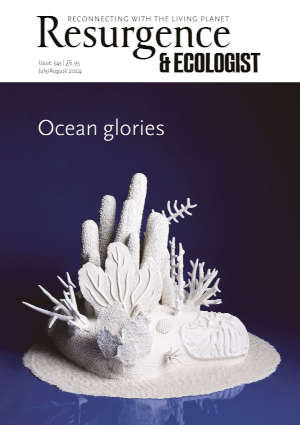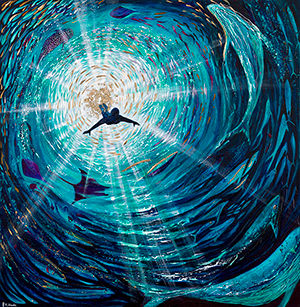I wasn’t supposed to specialise in the ocean. It just kind of happened. Like having a leisurely swim in the shallows, trying to put your feet down and – unable to touch the bottom – realising you’ve somehow ventured further than you thought.
Writing about the underwater world seems such a specific niche that most people are surprised when I tell them it wasn’t an active choice. As a scuba diver, I fell in love with the ocean the moment I first descended to 18 metres and saw sharks swirling above me, a turtle snoozing under a nearby ledge, and innumerable fish fluttering by.
In that moment I caught the bug, and my career edged closer to the ocean ever afterwards. There was no conscious moment when I decided to niche. I just couldn’t help it. By the time I incorporated my business The Ocean Writer Ltd. I was already writing about the ocean whenever I could.
But why? There’s no doubt I’m a thalassophile (someone who feels deeply connected to the ocean), but I think it’s more than that. There are so many unanswered questions in and about the ocean, and my inner detective wants to get to the bottom of all of them.
According to Seabed 2030, only 24.9% of the ocean floor has been mapped and scientists believe most species in the ocean are yet to be described. (The predicted figure of unknown ocean species in 2011 was as high as 91%.) The vast ocean remains full of mysteries, and I can’t help but keep pulling the thread to see what might unravel.
I was recently lucky enough to meet the legendary oceanographer Sylvia Earle, who has spent thousands of hours underwater exploring and conducting research. At 88, she still has questions, such as how migratory species like tuna travel through the vast ocean and find their way home with such precision.
Ask any marine researcher, and they’ll likely have a burning ocean mystery they’d love to solve too. For example, Mohamed Fauz Fath-hee, RahVeshi Programme Coordinator at the Manta Trust’s Maldives Manta Conservation Programme, is intrigued to learn where the Maldives’ oceanic manta ray population come from and travel to, and whether they have a connection with the Sri Lankan population.
The Maldives has the world’s third-largest known oceanic manta ray population, says Fath-hee, with more than 950 documented individuals. Over 85% of these congregate around the southern atoll of Fuvahmulah, and there’s a two-to-three-week period each year when divers can see five to seven mantas per dive.
“Notably, over 90% of these sightings unveil previously undocumented individuals, underscoring the transient nature of these creatures as they gracefully vanish after just a few hours in the area,” Fath-hee says. If they do travel to Sri Lanka, they could be among the thousand-plus mantas hunted for their gill plates each year. To properly protect these enigmatic animals, we need the right knowledge.
Plankton ecologist Kevin Flynn of Plymouth Marine Laboratory has been following up on his deep curiosity too. His work has drawn him into exploring something called the mixoplankton paradigm. It turns out that much of what we thought we knew about plankton was wrong.
“Over the last decade we have realised that many of the photosynthetic plankton (the phytoplankton) are not growing as marine science has thought for the last century,” he explains. “They not only fix carbon dioxide like land plants do, but they eat … bacteria, their competitors, sometimes even their predators.” Some of these mixoplankton even steal body parts from other plankton to allow them to obtain nutrients by eating as well as through photosynthesis. This revelation not only gives us a cool new fact about how the ocean ecosystem operates, but also highlights the importance of having an open mind, says Flynn: “Because we were not looking for it; we were making preconceived judgements based on how life on land works.”
This discovery was discombobulating. “If marine science has managed to miss the importance across the oceans of such a fundamental trick of Nature as this, what else is waiting to be discovered?”
It seems that the more we learn, the more the plot thickens. Scientists recently confirmed the first recorded case of a lone orca killing a great white shark, which raised the question, what mechanism does a killer whale use to tear the shark open? Similarly, we recently saw the first documentation of humpback whales having sex, and the realisation that they were two males left researchers asking, are they doing this for social bonding, showing dominance, or something else? Each answer is another cliffhanger, leaving us wanting more.
There are still many things we know we’ve missed. Experts still have no idea where whale sharks or mantas give birth. Humaam Nihad, an intern at the Maldives Manta Conservation Programme, would love to know the answer to this question, as well as where juvenile whale sharks spend the first years of their lives. Finding the answer is important for conservation, he explains: “As neither of these animals has been seen giving birth in the wild, it would be crucial to protect the areas that these endangered animals use for these life stages.”
How can we properly conserve and restore important ecosystems if we don’t know which habitats species use, and how? Similarly, how can we protect biodiversity from human activities and the impacts of climate change if we don’t know how it’s affected by them?
Like me, scientists and conservationists around the world are searching for the answers to the ocean’s compelling mysteries. And, as the ocean supports all life on Earth, it’s essential that they do.








